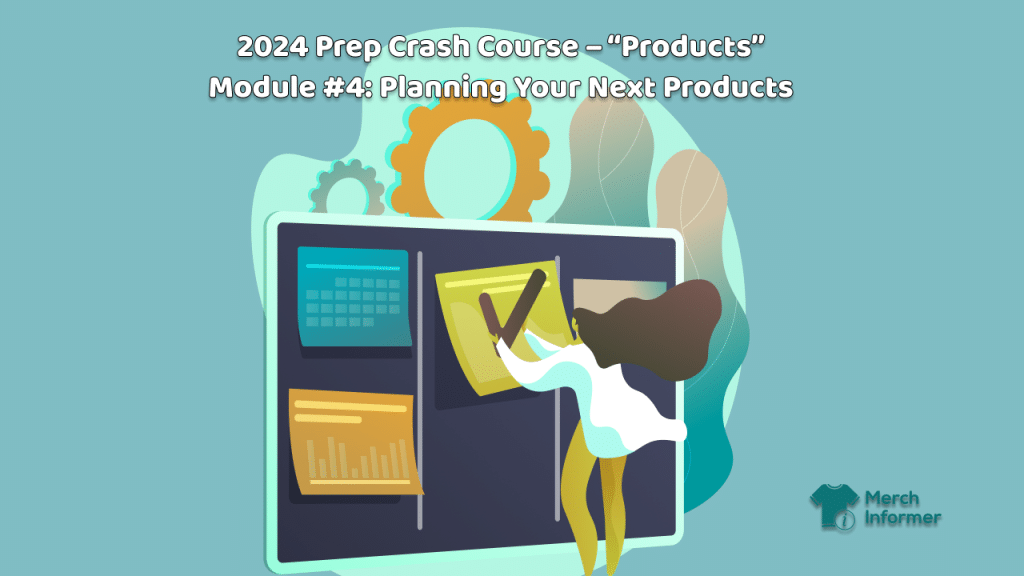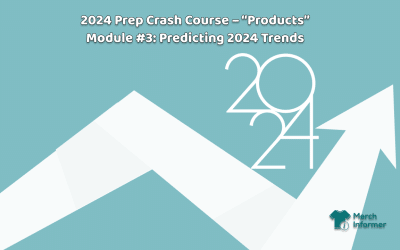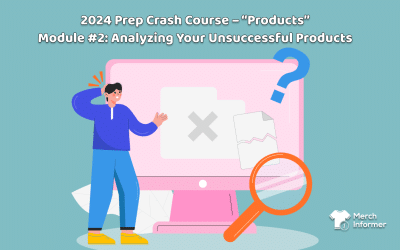2024 Prep Crash Course – “Products” Module #4: Planning Your Next Products
Merch by Amazon has empowered designers to create and sell a wide array of apparel, accessories, and merchandise to a global audience. In this ever-evolving landscape, the ability to capitalize on missed opportunities and unexplored product ideas is a key strategy for planning new products for the upcoming year.
In the last two modules, we gathered data from 2023 for two key sources of information:
- Successful products
- Unsuccessful products
Now you know what kind of products to replicate and which ones to avoid. It’s time to start putting this data to work, planning your next line of products.
My recommendation is to start with your “backlog”. The products that you planned to get to but couldn’t for one reason or another. Once you’ve determined – based on your experience in the last two modules – which of these undeveloped ideas merit the investment of time and money, you should also strip-mine off-your-radar opportunities.
These opportunities will inform your creativity as you flesh out the product plan that started with your backlog.
Here is a formula to help you determine which unproduced ideas should move forward and what new ideas can be built on them.
- Put all your unproduced products in a list and prioritize them based on the following criteria:
- Quick to produce
- Low Resource Demand
- Low cost for MOQ (minimum order quantity)
- Margin
- Proven Demand – this could be:
- A current hot trend
- a hot trend that has not yet plateaued
- an evergreen topic
- Marketing simplicity
Rate each product on a scale of 1-5 for each of the above criteria. The ones that rate better should move forward. The ones that rate worse should go wherever you file “Someday I’ll Get to That” projects (NEVER throw anything away!)
EXAMPLES:
A product that should move forward would look like this:
-
- Quick to produce; YES
- Low Resource Demand: YES
- Low cost for MOQ (minimum order quantity): YES
- Margin: >100%
- Proven Demand – this could be:
- A current hot trend
- a hot trend that has not yet plateaued
- an evergreen topic YES
- Marketing simplicity YES
In sum, this is the sweetspot: find a concept that can be produced quickly, has a low enough cost for the MOQ that you have earmarked capital for, produce 2x it’s cost through your sales channels, for a popular topic/event/personality that has proven longevity in the public eye, that can be marketed for little to nothing.
A product that should be filed away (NOT thrown out) would look like this:
-
- Quick to produce: NO
- Low Resource Demand: NO
- Low cost for MOQ (minimum order quantity): YES
- Margin: 17%
- Proven Demand – this could be:
- A current hot trend YES
- a hot trend that has not yet plateaued
- an evergreen topic
- Marketing simplicity YES
This looks like a mixed bag, but it’s a definite “no” for a couple of reasons. The two “yeses” can be manipulated if your emotional relationship to the concept is strong: “It’s a hot trend and it won’t cost me much and it should sell itself, so why not take a chance?” This blinds you to the other red flags that are important structural elements of a successful product.
This product will be slow to produce and have a high demand on resources, whether that’s time or money. 17% is a very low net margin. “Slow” and “current hot trend” are natural enemies. This conflict alone should kill this product as you’re developing your new product line.
Let’s break each of these criteria down.
REFLECTING ON MISSED OPPORTUNITIES
What Did You Want to Create but Didn’t Get to?
Planning for the future begins with reflection on the products or designs that you had envisioned but didn’t materialize. These could range from unique apparel designs to accessories and beyond.
Time is your ally here. It’s probably been some time since you looked at these ideas – they’re certainly familiar, but there’s more freshness through this lens. The exercise of analyzing your successful and unsuccessful products allows you to see these concepts in a new light.
Understanding the Obstacles: Why It Didn’t Happen
Equally important is comprehending why these opportunities were missed. Obstacles can take the form of design challenges, resource constraints, or market dynamics such as shifting trends or unforeseen events.
Can you unlock these concepts by making changes to the situations in the last paragraph? Can you clear your design challenges with other resources? Are you in a position now to even bring on those other resources? Has your eye for trends become keener? Has your workflow become nimbler?
ANALYZING MARKET DEMAND
Market Research: Is There a Demand for Missed Products?
Identifying missed opportunities is merely the initial step. Thorough market research is essential to ascertain whether there’s a genuine demand for these products. This research involves assessing whether there is a gap in the market or if consumer preferences have evolved.
The hardest experience I’ve ever had with this step is discovering that someone else had beat me to the market with an identical idea. Totally parallel development, never met the guy, the design was similar but had some differences I hadn’t thought of, but there he was. He was out there. In my space, my territory. That it supported the validity of the concept was cold comfort; if I enter the marketplace I’ve lost first mover advantage and will be seen as a copycat.
If a gap you previously identified in the marketplace is now filled by another player, you have to decide whether your product will compete on its own merit or if you have to increase your marketing spend and price your product competitively against the first mover.
Consumer Preferences: Do Missed Products Align with Trends?
Consumer preferences and fashion trends are in a perpetual state of flux. To ensure the potential success of missed opportunities, alignment with current and emerging trends is critical. Understanding what resonates with the target audience is indispensable.
This is an enlightening process:
-
- Take your sales data, and lay the sales data for both successful unsuccessful products next to each other.
- Then take the overall trends data and lay that next to the other two.
- Lastly, see how the actuals map to the predictions. Just do a simple Google search of “2023 merch by amazon trend predictions” and there will be several pieces on the first results page alone that will help you assemble a picture of what “experts” predicted as trends for 2023.
- Look at the four graph lines (or numbers, however you prefer).
Do the trend lines follow each other? Where don’t they? Does the divergence match any divergence between predicted vs. actual trends? Does this tell you if you’re better at keeping up with/predicting trends or do you discover niches where the popular trends diverge?
EVALUATING RESOURCE REQUIREMENTS
Resource Assessment: Do You Have What It Takes?
Before proceeding, a comprehensive evaluation of the required resources is necessary. Designers should assess whether they possess the necessary design skills, time, and financial resources to bring the missed opportunities to fruition.
Budget and Cost Considerations: Can It Be Done Profitably?
Careful consideration of the potential costs involved in producing and marketing the missed products is vital. It’s essential to determine whether launching these products can be executed profitably and if the expected returns justify the investment.
Capital comes into play here, and at the end of the year it’s always good to have capital out so (in many cases) it may reduce that year’s tax liability.
Where does your capital come from? Were your successful products profitable enough that you can reinvest in the new products?
IDENTIFYING NEW OPPORTUNITIES
Innovative Twist: Can You Put a Fresh Spin on Missed Ideas?
Rather than pursuing missed opportunities exactly as originally conceived, you should explore innovative ways to breathe fresh life into these ideas. Perhaps a cultural or entertainment event happened in the past year and integrating it into your concept would make it more appealing.
Niche Exploration: Unearthing Untapped Niches
In the expansive realm of Merch by Amazon, untapped niches often await discovery. Identifying these niches and comprehending the specific needs of niche markets can open up new avenues for missed opportunities.
The data you pulled should show you where there are undiscovered niches. You’ll find them in the gaps between the successful products, the unsuccessful products, the trend line you followed and the trend line you bucked. Draw these out in a Venn diagram and the intersections will be most telling.
REVISING YOUR PRODUCT LINEUP
Product Lineup Strategy: Balancing Old and New
With missed opportunities reassessed and new ideas explored, the next step is to develop a revised product lineup for the upcoming year. This lineup should strike a balance between classic designs that have proven their appeal over time and innovative creations inspired by the missed opportunities.
Marketing and Promotion: Aligning with Missed Opportunities
Effective marketing and promotional strategies are paramount. These strategies should emphasize the innovative and fresh aspects of the new products arising from missed opportunities. Content and campaigns should highlight how these products cater to the needs and desires of the target audience.
The key takeaway is that every missed opportunity can be transformed into a future triumph. Whether it’s launching unique apparel designs, accessories, or any other unexplored product, producers have the opportunity to adapt, refine, and create content that resonates with their target audience.
In the words of renowned entrepreneur Richard Branson, “Opportunities are like sunrises. If you wait too long, you miss them.” By applying these strategies, Merch by Amazon producers can harness the potential of missed opportunities, turning them into open doors leading to a successful future in the world of creative design.








